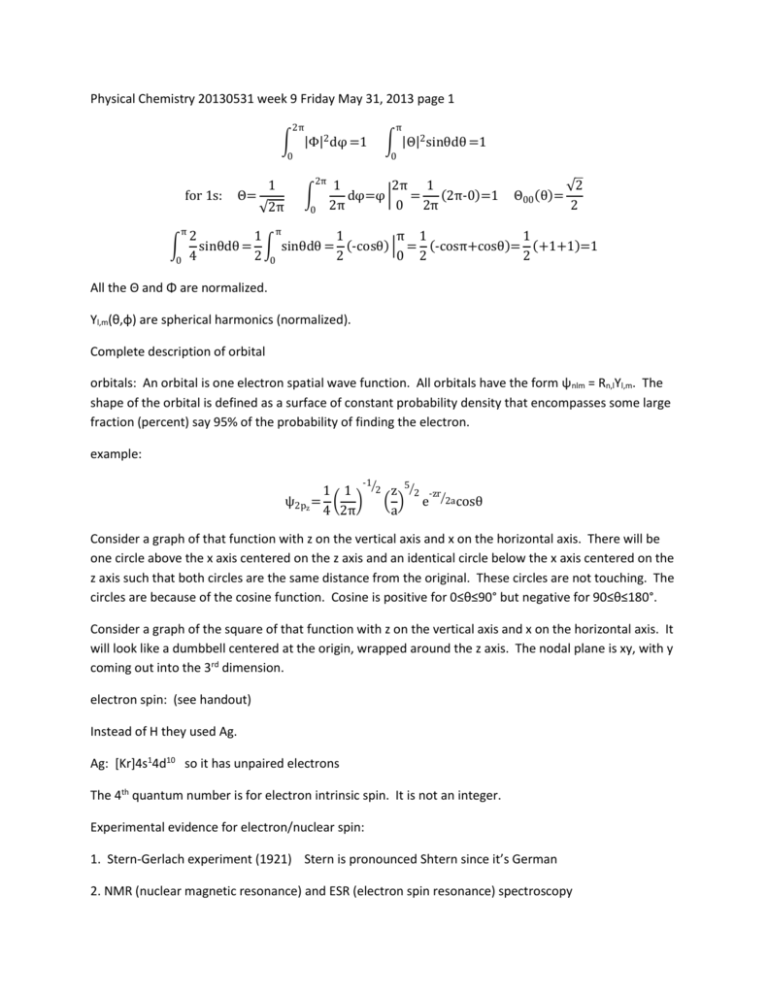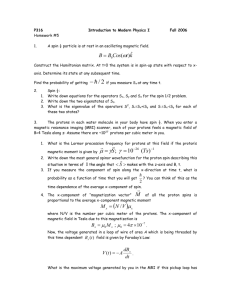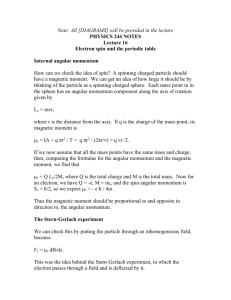Physical Chemistry 20130531 week 9 Friday May 31 2013
advertisement

Physical Chemistry 20130531 week 9 Friday May 31, 2013 page 1 2π π ∫ |Φ|2 dφ =1 0 for 1s: π ∫ 0 Θ= 1 √2π ∫ |Θ|2 sinθdθ =1 0 2π ∫ 0 1 2π 1 dφ=φ | = (2π-0)=1 2π 0 2π Θ00 (θ)= √2 2 2 1 π 1 π 1 1 sinθdθ = ∫ sinθdθ = (-cosθ) | = (-cosπ+cosθ)= (+1+1)=1 4 2 0 2 0 2 2 All the Θ and Φ are normalized. Yl,m(θ,φ) are spherical harmonics (normalized). Complete description of orbital orbitals: An orbital is one electron spatial wave function. All orbitals have the form ψnlm = Rn,lYl,m. The shape of the orbital is defined as a surface of constant probability density that encompasses some large fraction (percent) say 95% of the probability of finding the electron. example: -1⁄ 2 1 1 ψ2pz = ( ) 4 2π z 5⁄2 -zr ( ) e ⁄2a cosθ a Consider a graph of that function with z on the vertical axis and x on the horizontal axis. There will be one circle above the x axis centered on the z axis and an identical circle below the x axis centered on the z axis such that both circles are the same distance from the original. These circles are not touching. The circles are because of the cosine function. Cosine is positive for 0≤θ≤90° but negative for 90≤θ≤180°. Consider a graph of the square of that function with z on the vertical axis and x on the horizontal axis. It will look like a dumbbell centered at the origin, wrapped around the z axis. The nodal plane is xy, with y coming out into the 3rd dimension. electron spin: (see handout) Instead of H they used Ag. Ag: [Kr]4s14d10 so it has unpaired electrons The 4th quantum number is for electron intrinsic spin. It is not an integer. Experimental evidence for electron/nuclear spin: 1. Stern-Gerlach experiment (1921) Stern is pronounced Shtern since it’s German 2. NMR (nuclear magnetic resonance) and ESR (electron spin resonance) spectroscopy 3. The fine structure splitting of atomic spectra 4. The degeneracy of excited states of atoms and molecules 5. The anomalous Zeeman effect (energy of electron in magnetic field) electron spin ⇀ L |L|=√l(l+1)ℏ l=0,1,2,3,… quantized Lz is z component of angular momentum. Lz = mℏ m= 0,±1,±2,±3,… follows l spin angular momentum → → and (z component) S Sz |S|=√s(s+1)ℏ s=0,1,2,3,… 1 3 5 or s= , , ,… 2 2 2 s is spin angular momentum quantum number say s= → Sz 1 1 1 then ms can be+ or2 2 2 Sz =ms ℏ ms =-s,-s+1,…,s-1,s For l we had ml or just m. For s we have ms or just m. For electron s = 1 so ms = 2 1 2 or - 1 2 1 There are 2s+1 orientations so 2 ( ) +1=2 2 Consider a graph with z on the vertical axis. For ms=1/2, the vector starts at the origin and goes up and right a distance of ℏ √(3/4) such that the vertical height is ℏ/2. Likewise, for ms=-1/2, the vector starts at the origin and goes down and right a distance of ℏ√(3/4) such that the vertical height is -ℏ/2. 1 1 3 |S|=√ ( +1) ℏ=√ ℏ 2 2 4 All electrons have spin of ½. Photons have spin of 1(which is how polarized light is possible). α = spin function α=α(ω) ω is lower case omega ω is hypothetical internal coordinate β = spin function β=β(ω) ψ(x,y,z) = spatial wave function ψ1Sα = 1Sα ψ1sβ = 1sβ spin orbital wave function The helium atom and the Pauli Principle Consider a system of 3 particles. One particle is the nucleus of the helium atoms, which has charge ze. Another particle is the first electron e1. Another particle is the second electron e2. The distance from the nucleus to e1 is r1. The distance from the nucleus to e2 is r2. The distance from e1 to e2 is r12. There is potential energy associated with each of those 3 distances. 2 2 2 -ℏ2 2 ℏ2 2 ze' ze' e' ̂= H ∇1 ∇2 + 2me 2me r1 r2 r12 -ℏ2 2 ∇ for electron 1 2me 1 -ℏ2 2 ∇ for electron 2 2me 2 e' since in cgs units me should actually be μ but me is close enough Positive potential energy means repulsion. Negative potential energy means attraction. Because of the r12 term we can’t separate the variables to solve. This means we can’t get an exact answer so we have to use approximation methods instead. r1 =√x12 +y12 +z12 ̂ ψ=Eψ Use ψ for He, not H H ψ=ψ(x1,y1,z1,x2,y2,z2) so ψ is function of spatial coordinates only In spherical coordinates: ψ=ψ(r1,θ1,Φ1,r2,θ2,Φ2) 2 e' Ignore the terms to simplify (so it ' s possible to solve): r12 Ĥ = Ĥ1 + Ĥ2 so we’re assuming the electrons don’t interact, then: 2 -ℏ2 2 ze' Ĥ1 = ∇ 2me 1 r1 Those can be solved exactly. Ĥ1ψ1 = E1ψ1 and 2 -ℏ2 2 ze' Ĥ2 = ∇ 2me 2 r2 Ĥ2ψ2 = E2ψ2 For H-like atom (to approximate each electron in He atom): E1 =- ( E1 = total energy = Etot = -108.8eV z2 ) 13.6eV n2 For He z=2 so z 2 =4 so: -4 13.6eV= -54.4eV and E2 = -54.4eV 1 which is about 38% error








